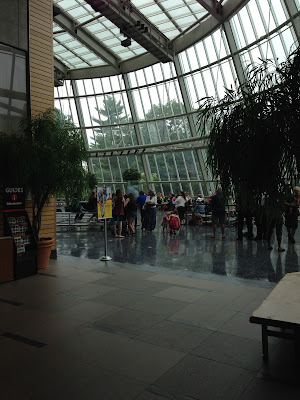 |
| photo from visitcherokeenation.com |
Name: Cherokee Heritage Center
Tribe: Cherokee Nation, United Keetoowah Band of Cherokee Indians
Location: 21192 S. Keeler Drive, Park Hill, OK 74457
Type: Cultural Heritage Complex
Visiting Info: Open year round, Summer (Memorial Day through Labor Day) Mon-Sat, 9am - 5pm, Winter (except Jan 1-14: closed) Tues-Sat, 9am - 5pm; Admission: $5-$8.50.
Contact: Website, telephone 888-999-6007
The Cherokee Heritage Center is a complex of attractions that includes the Cherokee National Museum, the Trail of Tears exhibit, Diligwa - The 1710 Cherokee Village, Adams Corner Rural Village, Nofire Farms, the Cherokee Family Research Center, and the Cherokee National Archives.
The Center also offers special exhibits, cultural workshops, and events, including the Cherokee National Holiday celebration, the Trail of Tears Art Show and Sale, and the Homecoming Art Show.
Artifacts, cultural objects, and art pieces from the span of Cherokee history are on display in the Museum and the Trail of Tears exhibit.
The Diligwa village depicts a traditional Cherokee settlement in the 18th century prior to assimilation. Docents guide visitors through the encampment, explaining traditional culture, crafts, hunting techniques, and games. The self-guided Adams Corner Rural Village and Nofire Farms show what tribal towns looked like after assimilation and the horrors of the Trail of Tears. Set in the 1890's, the seemingly bucolic Rural Village presents the turmoil faced by the Cherokee as Indian Territory began its transition to Oklahoma statehood.
The Heritage Center is also home to the Cherokee National Archives, and admission to the complex provides visitors with access to the Cherokee Family Research Center and their genealogical resources. Staff are available to help researchers access Dawes Commission records and the Final Rolls, Seminary records, Cherokee cemetery documentation, and citizenship resources.
The Center is located just to the south of Tahlequah, the Cherokee Nation's capitol, on the grounds of the original Cherokee Female Seminary in an old settlement called Park Hill. The spot is of great historic significance as Park Hill was the home of many important tribal leaders, such as John Ross, in the period after the Removal, and the Seminary was the first educational institution for women west of the Mississippi River.
Park Hill is also home to the John Ross Museum, Ross Cemetery, and the Murrell Home.
The Center also offers special exhibits, cultural workshops, and events, including the Cherokee National Holiday celebration, the Trail of Tears Art Show and Sale, and the Homecoming Art Show.
| Trail of Tears Exhibit photo from cherokeeheritage.org |
Artifacts, cultural objects, and art pieces from the span of Cherokee history are on display in the Museum and the Trail of Tears exhibit.
The Diligwa village depicts a traditional Cherokee settlement in the 18th century prior to assimilation. Docents guide visitors through the encampment, explaining traditional culture, crafts, hunting techniques, and games. The self-guided Adams Corner Rural Village and Nofire Farms show what tribal towns looked like after assimilation and the horrors of the Trail of Tears. Set in the 1890's, the seemingly bucolic Rural Village presents the turmoil faced by the Cherokee as Indian Territory began its transition to Oklahoma statehood.
| The Swimmer School at the Adams Corner Rural Village photo from cherokeeheritage.org |
The Heritage Center is also home to the Cherokee National Archives, and admission to the complex provides visitors with access to the Cherokee Family Research Center and their genealogical resources. Staff are available to help researchers access Dawes Commission records and the Final Rolls, Seminary records, Cherokee cemetery documentation, and citizenship resources.
The Center is located just to the south of Tahlequah, the Cherokee Nation's capitol, on the grounds of the original Cherokee Female Seminary in an old settlement called Park Hill. The spot is of great historic significance as Park Hill was the home of many important tribal leaders, such as John Ross, in the period after the Removal, and the Seminary was the first educational institution for women west of the Mississippi River.
Park Hill is also home to the John Ross Museum, Ross Cemetery, and the Murrell Home.
Resources:


















